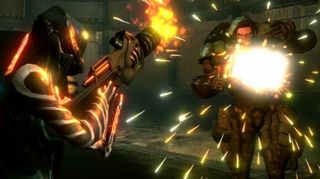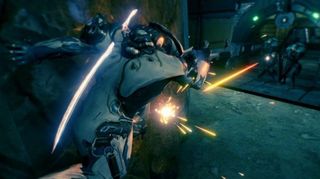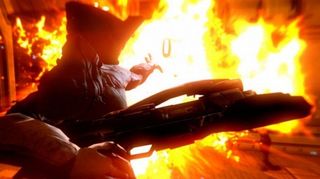Warframe: an inside look at the popular free-to-play space-ninja fighter

"You wanna be a space ninja?"
That was the cry Digital Extremes PR settled on at PAX when tempting booth loiterers to play Warframe , a PvE third person shooter involving space ninjas. Turns out, because booth loiterers are only human, the answer was a resounding yes.
The game is currently in open beta and has been since March. You might have seen it hovering around the periphery of the Steam most-played top ten and, occasionally, venturing in. With its ninth update the developers announced 3 million registered accounts and you might see anything from 10,000 to 30,000 concurrent players on its servers.
"Do you want to join a space ninja dojo?"
But despite their apparent popularity the game didn't actually start out with space ninjas per se. "We just sort of built the game," says Steve Sinclair, creative director at Digital Extremes. "The last games we made were cover shooters and we were fed up with that, so let's do something crazy agile. Let's put knee sliding and wall running and spinning and melee attacks - they became space ninjas a little bit without us knowing." At PAX that description resonated with gamers and the label stuck. "Most people's eyes light up when we say that so we keep banging on that drum."
The game is a work-in-progress, as signposted by the open beta tag. My own first few missions were enjoyable - the movement and attack animations give your Warframe a pleasing veneer of elegance regardless of your skill level and shooting Grineer - denizens belonging to an evil alien empire - the in the face or bringing your blade crashing down on them is satisfying. But ultimately the experience felt a little weightless and repetitive. It didn't seem to matter whether the objective was a hostage escort mission or a quest to destroy a reactor, I was moving from point A to point B shooting and slashing with little sense of purpose.
The regularity of updates and special events makes it hard to judge how far that will change as the game progresses and builds. As it stands, whether you enjoy the game will pretty much depend on whether spending time practicing and mastering the combat and weaponry is your thing or not. In short: do you want to join a space ninja dojo? A lot of people do, and the game is home to veterans with hundreds of hours under their belts.

"We try to do events every few weeks and we add new content and weapons pretty much weekly. We do major updates every 4-6 weeks and that's really our lifeblood. Every time we do that it leads to a big surge in players," explains Sinclair. He attributes the success partly to these things but also to allowing the community to get involved from very early in the game's development. "We have a loyal following because we've involved them directly in making the game and we've communicated with them and listened to them, turned their desires into making the game more their own."
The biggest gaming news, reviews and hardware deals
Keep up to date with the most important stories and the best deals, as picked by the PC Gamer team.
"Grand Master tier will set you back $249.99"
Warframe operates a Kickstarter-esque tiering system with those who give the highest funding for the game being given the chance to be part of the decision making for the game in the Design Council. They're not exactly cheap - the Master tier costs $99.99 while Grand Master will set you back $249.99 and so I ask whether the price tags are justified. "When we launched we had the same wincing thing - is this the right thing to do?" admits Sinclair. But the Warframe Founder programme proved well-timed in terms of tapping into crowdfunding impulses (at the time Double Fine were smashing funding targets with their Broken Age Kickstarter in another corner of the internet) and so began picking up investors.
"If ninjas in space resonated with you and you had money you wanted to throw at that problem and see the game built and influence it's direction then yeah, you'd obviously be spending a lot more than a box product," says Sinclair."This is a hobby for them. We don't see a lot of people regretting that. The last Warframe we added was called Nova and she was built by the Design Council. They voted on what her theme was, then the came up with a concept for her power and voted for that, then they came up with a concept for her name and voted on that. We really think we're delivering that value. They're seeing how the sausage is made."

I ask Sinclair about the veterans with those hundred-plus timestamps on their accounts. What keeps them coming back? "They come back because we have a system called mastery which is borrowed from Crouching Tiger, Hidden Dragon. The scene where the two women are fighting and they're taking every single weapon off the wall and they're experts in each. We have this level curve with each item you get. Kind of like Ratchet and Clank, everything levels independently. But once you max out a weapon your mastery doesn't increase unless you switch up weapons. A lot of these long-term players are climbing that Himalayan mountain of mastering every single thing that exists in the game."
"The mastery system is borrowed from Crouching Tiger, Hidden Dragon."
Mastery also often sees experienced players heading back to earlier missions in the interests of farming up crafting resources like ferrite. It can actually be problematic if you're just getting started. I joined my second ever mission expecting to bumble along with fellow low-rankers, shooting Grineer in the face and hopping around on top of boxes. What actually happened was I spent the entire time holding my finger down on the shift key so I could chase behind power players who used skills and weapons not even in my arsenal to take out all targets before I could so much as point my gun in vaguely the right direction.
"I think that's a bit of naivete in the way our matchmaking system is working because those early starting areas," admits Sinclair. "Some of the players come back because there are resources that fit into our crafting system so they'll come in there, you'll get matched in with them and they'll speed run and murder. You'll be left as this slack-jawed passenger, not being able to participate. But those are definitely things we're working on."

Another work in progress is the microtransactions element, although the team largely feel they have a handle on what the community want. Listening to Steve, it was not exactly the smoothest learning curve. "With singed eyebrows and asbestos underwear we've navigated those waters and our players have educated us with their flames!" He picks out an early example of a cap at level 15 where players couldn't continue unless they paid somewhere in the region of $2. "We congratulated ourselves and patted ourselves on the back," he laughs.
The players hated it. "We ripped out that system based on their feedback and completely changed it." Nowadays the level caps are gone and all the gear is available via the crafting system or missions which pop up through the alert system from time to time. The team also monitors community feedback to make sure additions and updates aren't having an unwanted effect on the in-game balance. "We avoid pay-to-win like the plague."
"We ripped out that system based on their feedback and completely changed it."
The team are currently focused on ironing out bugs with update 9 but update 10 promises a big expansion of dojos - clan-built arenas that can host PvP battles, new enemy types and colony types. "We have this really cool Tatooine, desert-type planet that the Grineer have settled on that we'll be adding in the near future," adds Sinclair. The dropping of the beta tag will likely coincide with a major update in the autumn.
The mention of dojo expansions prompts a final question - is Digital Extremes tempted to develop Warframe as an eSport? "We definitely are," says Sinclair. But there is a reluctance to push the idea too hard as the community's response to new players demanding PvP has generally been to tell them to get the hell out of a PvE game.
"We've started down that road a little bit. If a clan builds a duelling hall in their dojo they can have 1v1 competitions. Warframe is really fun to watch and we get a lot of eSports people saying 'You guys got to boost some competition elements because players would love to play Warframe at our event'. So with a bit of reluctance and not as a dominant focus of the game we are going to continue to experiment with that but it's certainly going to take a backseat to doing more of what's successful in the game - new enemies, new locations and really servicing our PvE audience."
Most Popular






